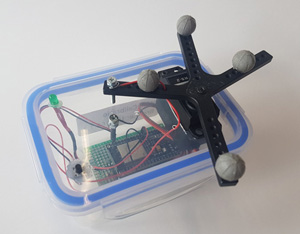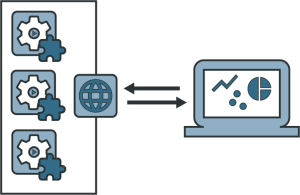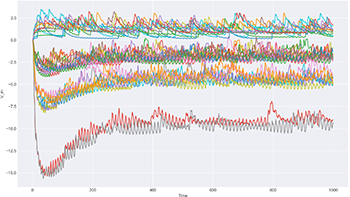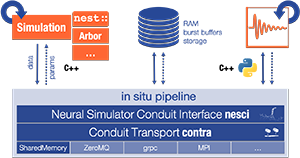Profile

|
Jan Müller, B.Sc. |
Publications
Calibratio - A Small, Low-Cost, Fully Automated Motion-to-Photon Measurement Device

Since the beginning of the design and implementation of virtual environments, these systems have been built to give the users the best possible experience. One detrimental factor for the user experience was shown to be a high end-to-end latency, here measured as motionto-photon latency, of the system. Thus, a lot of research in the past was focused on the measurement and minimization of this latency in virtual environments. Most existing measurement-techniques require either expensive measurement hardware like an oscilloscope, mechanical components like a pendulum or depend on manual evaluation of samples. This paper proposes a concept of an easy to build, low-cost device consisting of a microcontroller, servo motor and a photo diode to measure the motion-to-photon latency in virtual reality environments fully automatically. It is placed or attached to the system, calibrates itself and is controlled/monitored via a web interface. While the general concept is applicable to a variety of VR technologies, this paper focuses on the context of CAVE-like systems.
» Show BibTeX
@InProceedings{Pape2020a,
author = {Sebastian Pape and Marcel Kr\"{u}ger and Jan M\"{u}ller and Torsten W. Kuhlen},
title = {{Calibratio - A Small, Low-Cost, Fully Automated Motion-to-Photon Measurement Device}},
booktitle = {10th Workshop on Software Engineering and Architectures for Realtime Interactive Systems (SEARIS)},
year = {2020},
month={March}
}
Talk: Insite: A Generalized Pipeline for In-transit Visualization and Analysis

Neuronal network simulators are essential to computational neuroscience, enabling the study of the nervous system through in-silico experiments. Through utilization of high-performance computing resources, these simulators are able to simulate increasingly complex and large networks of neurons today. It also creates new challenges for the analysis and visualization of such simulations. In-situ and in-transport strategies are popular approaches in these scenarios. They enable live monitoring of running simulations and parameter adjustment in the case of erroneous configurations which can save valuable compute resources.
This talk will present the current status of our pipeline for in-transport analysis and visualization of neuronal network simulator data. The pipeline is able to couple with NEST along other simulators with data management (querying, filtering and merging) from multiple simulator instances. Finally, the data is passed to end-user applications for visualization and analysis. The goal is to be integrated into third party tools such as the multi-view visual analysis toolkit ViSimpl.
Streaming Live Neuronal Simulation Data into Visualization and Analysis

Neuroscientists want to inspect the data their simulations are producing while these are still running. This will on the one hand save them time waiting for results and therefore insight. On the other, it will allow for more efficient use of CPU time if the simulations are being run on supercomputers. If they had access to the data being generated, neuroscientists could monitor it and take counter-actions, e.g., parameter adjustments, should the simulation deviate too much from in-vivo observations or get stuck.
As a first step toward this goal, we devise an in situ pipeline tailored to the neuroscientific use case. It is capable of recording and transferring simulation data to an analysis/visualization process, while the simulation is still running. The developed libraries are made publicly available as open source projects. We provide a proof-of-concept integration, coupling the neuronal simulator NEST to basic 2D and 3D visualization.
@InProceedings{10.1007/978-3-030-02465-9_18,
author="Oehrl, Simon
and M{\"u}ller, Jan
and Schnathmeier, Jan
and Eppler, Jochen Martin
and Peyser, Alexander
and Plesser, Hans Ekkehard
and Weyers, Benjamin
and Hentschel, Bernd
and Kuhlen, Torsten W.
and Vierjahn, Tom",
editor="Yokota, Rio
and Weiland, Mich{\`e}le
and Shalf, John
and Alam, Sadaf",
title="Streaming Live Neuronal Simulation Data into Visualization and Analysis",
booktitle="High Performance Computing",
year="2018",
publisher="Springer International Publishing",
address="Cham",
pages="258--272",
abstract="Neuroscientists want to inspect the data their simulations are producing while these are still running. This will on the one hand save them time waiting for results and therefore insight. On the other, it will allow for more efficient use of CPU time if the simulations are being run on supercomputers. If they had access to the data being generated, neuroscientists could monitor it and take counter-actions, e.g., parameter adjustments, should the simulation deviate too much from in-vivo observations or get stuck.",
isbn="978-3-030-02465-9"
}
Talk: Streaming Live Neuronal Simulation Data into Visualization and Analysis

Being able to inspect neuronal network simulations while they are running provides new research strategies to neuroscientists as it enables them to perform actions like parameter adjustments in case the simulation performs unexpectedly. This can also save compute resources when such simulations are run on large supercomputers as errors can be detected and corrected earlier saving valuable compute time. This talk presents a prototypical pipeline that enables in-situ analysis and visualization of running simulations.

